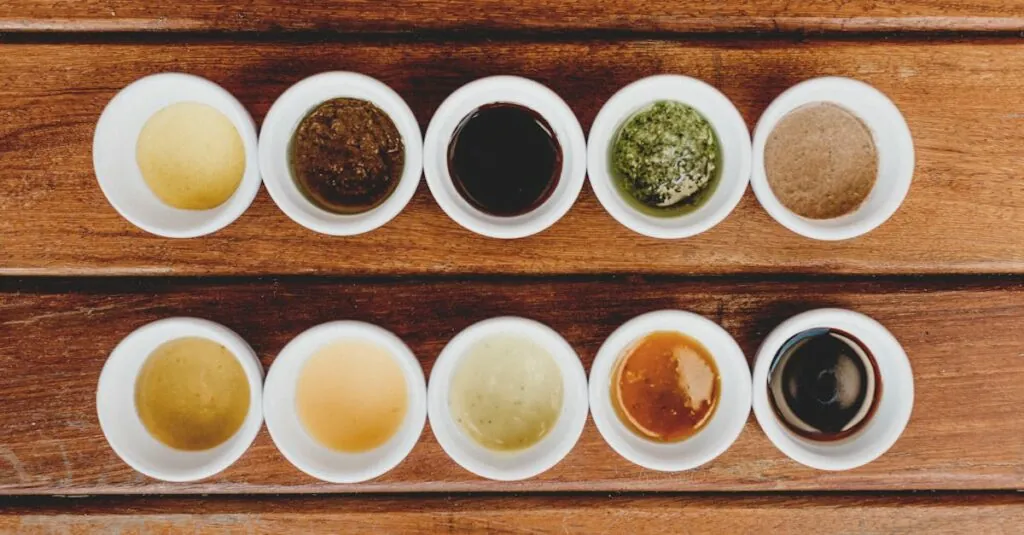Table of Contents
ToggleCooking isn’t just a chore; it’s an adventure waiting to unfold in your kitchen. With a variety of cooking methods at your fingertips, you can transform simple ingredients into culinary masterpieces—or at least something edible that won’t scare the neighbors. From the sizzle of frying to the gentle embrace of steaming, each technique brings its own flair to the table.
Ever wondered how a little heat can turn a humble potato into crispy fries or a tender roast? Mastering different cooking methods opens up a world of flavors and textures that can impress even the pickiest of eaters. So, whether you’re a novice chef or a seasoned pro, it’s time to dive into the delightful world of cooking techniques that’ll have your taste buds dancing and your guests begging for seconds.
Overview of Different Cooking Methods
Cooking methods influence flavor, texture, and overall dish appeal. Various techniques exist, each offering unique benefits for culinary enthusiasts.
Baking involves using dry heat in an oven to cook food evenly. It’s ideal for bread and cakes, allowing for a delightful rise.
Grilling exposes food directly to heat, either from below or above. This method enhances natural flavors and creates a sought-after char, perfect for meats and vegetables.
Steaming employs water vapor to cook food gently. It preserves nutrients and moisture, making it suitable for vegetables and seafood.
Frying uses hot oil to cook food quickly. It results in crispy textures, whether through deep or shallow frying. Various foods such as potatoes and chicken thrive in this method.
Sautéing cooks food quickly in a small amount of fat over high heat. It’s effective for vegetables and proteins, allowing for quick meals packed with flavor.
Roasting involves cooking food evenly using a dry heat process, often in an oven. This method browns the exterior while keeping the insides moist, commonly used for meats and root vegetables.
Poaching uses simmering liquid to gently cook food. It’s a delicate method that works well for eggs or fish, ensuring tenderness.
Sous vide is a modern technique involving vacuum-sealed food cooked in a water bath at precise temperatures. This method guarantees even cooking, enhancing flavors and textures.
Understanding these methods enables cooks to diversify their approach, ensuring every dish tells a story. Explore each technique to expand culinary abilities and impress guests.
Dry Heat Cooking Methods
Dry heat cooking methods utilize hot air or direct flame to cook food, enhancing flavors and textures without moisture. Common techniques include roasting, baking, and grilling.
Roasting
Roasting involves cooking food evenly in an oven, using dry heat. This method browns the exterior while keeping the inside moist, suitable for vegetables and meats. Cook times vary based on the size and type of the ingredients. Typically, larger cuts of meat require longer roasting times. The process allows the natural sugars in food to caramelize, enhancing flavors. Popular options for roasting include chicken, beef, and root vegetables like carrots and potatoes.
Baking
Baking is a technique that uses dry heat in an enclosed space, primarily ovens, to prepare a variety of dishes. It works best for creating breads, pastries, and desserts. Accurate temperature control plays a crucial role in achieving the desired texture and rise. Resting dough before baking allows flavors to develop further. Ingredients like flour, sugar, and butter combine with heat to create unique flavors and textures. Cook times are essential, with pastries needing precise timing to avoid over-baking.
Grilling
Grilling exposes food to direct heat from below, resulting in distinct grill marks and a charred flavor. This method is popular for meats, fish, and vegetables, enhancing their natural taste. Each grilling session requires attention to temperature, as different foods require various heat levels. The cooking process is quick, making it ideal for outdoor gatherings. Marinades can infuse additional flavor into meats while grilling. Popular grill options often include steaks, burgers, and seasonal vegetables.
Moist Heat Cooking Methods
Moist heat cooking methods incorporate steam or liquid to prepare food, enhancing flavors while preserving nutrients. These techniques provide gentle cooking environments that promote tenderness and taste.
Boiling
Boiling involves cooking food in water or broth at high temperatures, typically around 212°F (100°C). Pasta and rice often benefit from this method, producing even results throughout. It facilitates the introduction of flavors through seasoning in the water. Vegetables like potatoes and carrots also enjoy quicker cooking times, allowing for balanced textures. Adjustments can vary based on ingredient size and type, ensuring optimal doneness.
Steaming
Steaming cooks food using steam heat, which preserves moisture and nutrients effectively. This method operates at temperatures lower than boiling, generally around 180°F to 212°F (82°C to 100°C). Broccoli, asparagus, and fish emerge vibrant and tender when steamed. Utilizing a steamer basket or similar tool maintains separation from water, allowing for healthful preparations without added fats. Timing is crucial, as overcooking can lead to loss of color and nutrients.
Poaching
Poaching gently cooks food in simmering water or broth, maintaining a delicate texture and flavor. This technique typically ranges in temperature from 160°F to 180°F (71°C to 82°C). Eggs, chicken breasts, and fish fillets often showcase their best qualities when poached. Seasoning the poaching liquid enhances taste, inviting a rich depth to the dish. Careful attention to the cooking time ensures ingredients remain tender without becoming tough.
Combination Cooking Methods
Combination cooking methods blend dry and moist heat techniques, creating flavorful, tender dishes. These methods enhance texture while preserving moisture, making them suitable for various ingredients.
Braising
Braising combines both wet and dry cooking methods. This technique starts with searing food, usually meat, in fat or oil to develop a rich flavor. After browning, adding a small amount of liquid, like stock or wine, helps to create steam during the slow cooking process. The combination of high and low temperatures results in tender, flavorful meals. Common ingredients include tougher cuts of meat, like beef chuck or pork shoulder, which benefit from prolonged cooking. It’s an ideal method for creating hearty stews or savory pot roasts that develop complex flavors.
Stewing
Stewing closely resembles braising but differs in technique and ingredient proportions. For stewing, ingredients are cut into smaller pieces and fully submerged in liquid. This method works best for smaller cuts of meat, vegetables, and aromatics, which cook together over low heat for an extended period. As the stew cooks, flavors meld, and the broth becomes rich and savory. Broths or stocks often serve as the base, absorbing flavors from each component. Root vegetables like potatoes and carrots are commonly added, ensuring a complete meal in one pot. Stews offer a comforting, nourishing option, showcasing the depth of flavors that result from combining various ingredients.
Modern Cooking Techniques
Modern cooking techniques enhance traditional methods, elevating the culinary experience. These methods often emphasize precision and innovation, giving cooks the ability to create restaurant-quality meals at home.
Sous Vide
Sous vide involves sealing food in airtight bags and cooking it in water at precise temperatures. This technique ensures consistent results, yielding perfectly cooked proteins and vegetables. Chefs appreciate that sous vide retains moisture and enhances flavors, making dishes tender and succulent. Common practices include cooking eggs at lower temperatures or preparing steak to the desired doneness without overcooking. The process typically requires longer cook times, ranging from one to 48 hours, depending on the food item. With sous vide, experimentation leads to impressive culinary creations.
Microwave Cooking
Microwave cooking provides a quick and efficient method for preparing meals. This technique uses electromagnetic radiation to heat food, significantly reducing cooking time. It’s beneficial for defrosting, reheating leftovers, or cooking simple dishes like vegetables and popcorn. Most microwaves include settings for various tasks, allowing cooks to choose power levels and cook times with ease. Safety measures, such as using microwave-safe containers, help maintain food quality. Whether for busy weeknights or quick snacks, microwave cooking offers convenience without sacrificing flavor.
Exploring different cooking methods opens up a world of culinary possibilities. Each technique brings its own unique flair and can transform everyday ingredients into extraordinary meals. Whether it’s the crispy allure of frying or the tender results of poaching, understanding these methods allows cooks to experiment and innovate in the kitchen.
Encouragement to embrace both traditional and modern techniques fosters creativity and confidence. By mastering these diverse approaches, anyone can elevate their cooking skills and impress family and friends. The journey of cooking is as much about discovery as it is about flavor, inviting all to enjoy the art of preparing delicious dishes.







